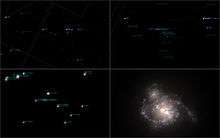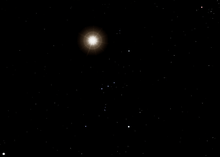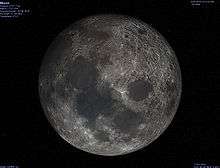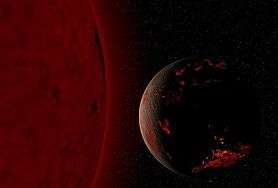Celestia
 | |
| Original author(s) | Chris Laurel |
|---|---|
| Developer(s) | Chris Laurel, Celestia developers |
| Initial release | 2001 |
| Stable release |
1.6.1 (10 June 2011)[1]
|
| Repository |
sourceforge |
| Operating system | AmigaOS 4, BSD, Linux, Mac OS X and Microsoft Windows |
| Size |
Linux: 27.7 MB AmigaOS 4: 44.4 MB Mac OS X: 38.7 MB Windows: 32.8 MB Source code: 52.6 MB[2] |
| Type | Educational software |
| License | GNU General Public License |
| Website |
celestiaproject |
Celestia is a 3D astronomy program created by Chris Laurel. The program is based on the Hipparcos Catalogue (HIP) and allows users to travel through an extensive universe, modeled after reality, at any speed, in any direction, and at any time in history. Celestia displays and interacts with objects ranging in scale from small spacecraft to entire galaxies in three dimensions using OpenGL, from perspectives which would not be possible from a classic planetarium or other ground-based display.
NASA and ESA have used Celestia in their educational[3] and outreach programs,[4] as well as for interfacing to trajectory analysis software.[5]
Celestia is available for AmigaOS 4, Linux, Mac OS X, and Microsoft Windows. Celestia is free software released under the GNU General Public License.
There are three graphical front-ends available: GLUT, GTK+ or Qt.
Celestia's final update came in 2011.[1] Since then, some of its development team have gone to work on either Celestia.sci,[6] a cosmological visualizer or SpaceEngine, a similar software but featuring more realistic graphics.
Functions


Celestia displays the Hipparcos Catalogue (HIP) of 118,322 stars. Celestia uses the very accurate VSOP87 theory of planetary orbits. This makes it possible to provide a solar and lunar eclipse finder and to display the orbital paths of planets (including extrasolar planets), dwarf planets, moons, asteroids, comets, artificial satellites, and spacecraft. The user can vary the number of stars that are visible on the screen and have them drawn in different styles.
Using simple keyboard controls, Celestia users can travel/fly through the Celestia universe at any speed from 0.001 m/s to millions of light years per second. Viewpoints can be set to look forward, backward, or at any angle to direction of travel. Controls allow users to orbit stars, planets, moons, and other space objects, track space objects such as spacecraft, asteroids, and comets as they fly by, or travel to and/or fly through nebulae and irregular, elliptical, and spiral galaxies (over 10,000 galaxies included).
The time simulated by Celestia can be set at any point in the future or past, although planetary orbits are only accurate within a few thousand years of the present day, and date arithmetic overflows at the year 5874774.
The names and positions of multitudes of objects in space can be displayed, from galaxies, star clusters, nebula, constellations, and stars to planets, moons, asteroids, comets, and artificial satellites, as well as the names and locations of cities, craters, observatories, valleys, landing sites, continents, mountains, seas, and other surface features.
Celestia displays such features as detailed atmospheres on planets and moons, planet shine on orbiting satellites, sunsets and sunrises, moving clouds, planetary rings, eclipse and ring shadows, constellation lines, borders and illustrations, night-side lights (of cities), detailed surface textures, specular reflections off water and ice, nebula gases, and star flares.
Information about the objects that Celestia draws can also be displayed. The radius, distance, length of the sidereal day, and average blackbody temperature of the planets are shown, and the distance, luminosity relative to the sun, spectral class, surface temperature, and radius of stars are indicated.
The user can change Celestia's field of view from as wide as 120 degrees to a highly magnifying 3.4 seconds of arc, while dividing the window into multiple panes, in order to observe several objects at the same time and including light time delay if desired.
Graphic screen-shots and movies can be captured in classic or HD resolutions (up to 1920x1080) on Windows and Linux platforms.
Celestia's support for game pads and joysticks is relatively limited, employing many keyboard shortcuts instead.
Celestia can be extended with new objects, and there are hundreds of third-party, user-created add-ons available for installation, both fictional and realistic. The extension mechanism uses Lua as its built-in scripting language. Educational lessons and computer lesson plans are available.
Limitations

The default setting for Celestia's Earth is a spheroid. The irregular surface of the Earth causes low Earth orbit satellites to appear to be in the wrong places in the sky when watched from Celestia's ground, even when the Earth's oblateness is specified.
Many types of astronomical objects are not included with Celestia. Variable stars, supernovae, black holes, and nebulae are missing from the standard distribution. Some are available as add-ons. Although objects that form part of a planetary system move, and stars rotate about their axes and orbit each other in multiple star systems, stellar proper motion is not simulated, and galaxies are at fixed locations. Celestia's binary star catalogs only describe a few hundred systems of multiple stars. Most binary star systems cannot be simulated because adequate orbital information is not yet available.
Celestia does not include any stars that are more than a few thousand light-years from the Sun because the parallaxes of more distant stars are too small to be accurately measured by the Hipparcos astrometric satellite. In addition, objects in solar systems are only drawn to a distance of one light-year from their suns, and Celestia does not consider the wobbling of some stars induced by their planets.
Wavelength filtering is not implemented in Celestia's engine. The actual rendering tries to match as closely as possible human vision at the observer's position. This means false-color maps and multi-color nebulae are not part of the official distribution. Camera lens artifacts like lens flare and glare are not rendered.
Celestia also does not simulate gravity. That means, for example, that a near-Earth object approaching the Earth will not collide with the planet after being caught by the Earth's gravity unless the person who defined the NEO's trajectory for Celestia included that effect.
Some of Jupiter's moons do not cast a shadow on Jupiter during eclipses. This is because irregularly shaped objects do not cast shadows in the current version of Celestia.
Most spacecraft such as the Voyager 2 are not available in Celestia but are provided as add-ons by users.
In the real world, constellations gradually change shape because stars will move over time, which Celestia does not take into account.
Celestia uses the Julian calendar and cannot go back or forward more than 2 billion years, and the default time-setting system cannot go further than the years -9999 or 9999.
Add-ons

Well over 10 GB of extensions are available in addition to the base program, produced by an active user community.[7]
High-resolution surface textures are available for most solar system bodies, including Virtual Textures with complete coverage up to 32768 pixels wide (1.25 km/pixel at the Earth's equator), with selected coverage at higher resolutions. This allows very close views of the Earth, Mars, and the Moon. Many 3D models of historical and existing spacecraft are available flying in reasonably accurate trajectories, from Sputnik 1 and Voyager 2 to the Hubble Space Telescope and International Space Station, as are extended data plots for stars (2 million with correct spatial coordinates). DSOs (nebulae, galaxies, open clusters, etc.), as well as catalogues of thousands of asteroids and comets, and more than 96,000 locations on the Earth can be drawn by the program. Add-ons also include extensive space objects such as red and blue supergiants, red and brown dwarfs, neutron stars, spinning pulsars, rotating black holes with accretion disks, protostars, star nursery nebula, supernova and planetary nebulae, galactic redshifts, geological planetary displays (e.g. 3D interiors, topographic and bathymetric maps, ice age simulations), planetary aurorae, rotating magnetic fields, animated solar flares and prominences, 3D craters and mountains, and historic collision events. All can be visited via the Celestia travel interface. All stages in the life cycle of stars are available, from protostar to black dwarf.
Numerous scripts are available. These include simple tours, reconstructions of complex space missions such as Cassini–Huygens and Deep Impact, and scripts showing useful information, like size comparisons, or particular events such as multiple simultaneous eclipses of Jupiter's moons or the evolution of a star.
Many well-known fictional universes are depicted in detail, with whole planetary systems and 3D models—films such as 2001: A Space Odyssey, Star Trek and Star Wars, and TV shows including Stargate SG-1 and Babylon 5. Add-ons illustrating less well known Web fiction, like Orion's Arm, or role-playing games, like 2300 AD, and detailed personal works by members of the Celestia community depicting extensive fictional solar systems with inhabited worlds, spacecraft, cities, and exotic special effects can also be obtained.

Educational add-ons (built by and for educators) are also available and are in use worldwide. These activities provide approximately 40 hours of space journeys and astronomical lessons to include extensive tours of the Celestia universe, the complete life cycle of stars, the solar system, the human space program, the Search for Extraterrestrial Intelligence (SETI), and depictions of astronomical events such as the formation of our moon billions of years ago, and the possible terraforming of Mars in the future. A special educational version of the Celestia program can also provide sound effects and "cockpit" features to simulate flying in a "real" hyperdrive spacecraft. Targeting the home user, middle and high school students, and beginning courses in collegiate astronomy, they are available in several languages.[8] They can also be obtained on CD or DVD for easy installation on school servers, teacher computers and home computers.[9][10]
In the media
Celestia was used in the media by the CBS television show NCIS (Season 4, Episode 22: "In the Dark"). Character Timothy McGee explains what Celestia is and how an add-on can allow the user to store a diary within the program, as well. Textures designed by Celestia graphic artists were used in the movie The Day After Tomorrow and the 2008 miniseries, The Andromeda Strain. Celestia has also appeared in the Science Channel's Through the Wormhole.
See also
- List of spaceflight simulator games
- Planetarium software
- Cartes du Ciel
- Digital Universe Atlas
- Google Mars
- Google Moon
- Google Sky
- KStars
- Hallo Northern Sky (HN Sky)
- NASA World Wind
- Orbiter (simulator)
- Frontier: Elite II
- Frontier: First Encounters (Elite III)
- Pioneer Space Simulator
- RedShift
- Skyglobe
- SpaceEngine
- Starry Night
- Stellarium
- TheSky
- Universe Sandbox
- WinStars
- WorldWide Telescope
- XEphem
References
- 1 2 "Celestia: News". Celestia: Home. 10 June 2011. Retrieved 29 September 2015.
- ↑ "Celestia - Browse Files at SourceForge.net". SourceForge. Geeknet, Inc. Retrieved 9 June 2011.
- ↑ "Celestia Exploration Activity". NASA Learning Technologies. National Aeronautics and Space Administration. 2005. Retrieved 2007-10-26.
- ↑ "Mars Express orbit lowered". Closing in on the Red Planet. European Space Agency. 2003. Retrieved 2007-10-26.
Upcoming Mars Express flight orbits until 7 January, getting closer to the Red Planet. Generated with Celestia software.
- ↑ Schouten, G. "Space Trajectory Analysis (STA)" (PDF). Delft University of Technology.
- ↑ "celestia.sci sources". Celestial Matters Forum. 2014-04-10. Retrieved 29 September 2015.
Celestia (the development of which has stopped)
- ↑ The Celestia Motherlode
- ↑ The Celestia Motherlode: Educational Activities
- ↑ Obtaining Celestia Educational Activities
- ↑ Installation instructions for the add-ons are available on the Wikibooks page
External links
| Wikimedia Commons has media related to: |
| Wikibooks has a book on the topic of: Celestia |
- Official website
- Sourceforge project page Binaries and source code
- Celestia Addons ST add-ons made by fan modelers
- Celestia Motherlode Collection of add-ons made by various people
- Celestia Motherlode educational Resources Celestia Educational page
- Celestia Educational Activities Purchase
- Page on Celestia hosted by NASA
- Instance of ESA using Celestia

